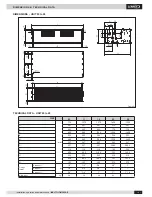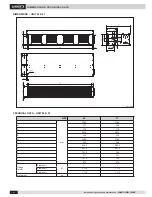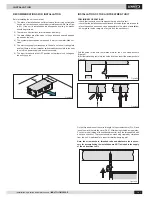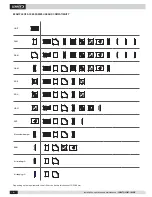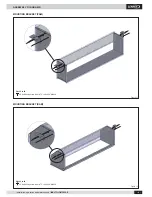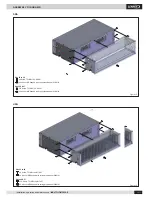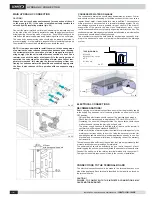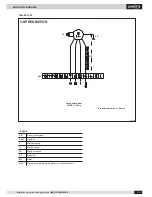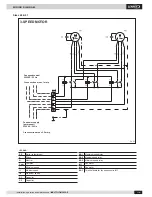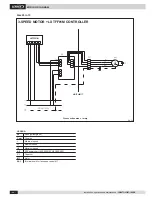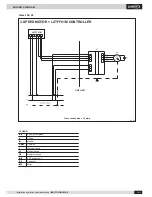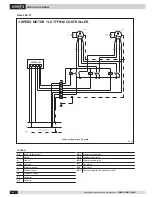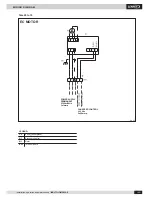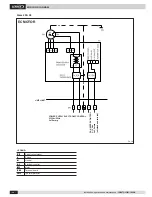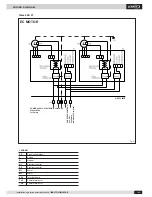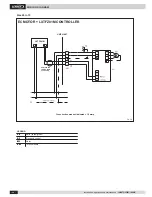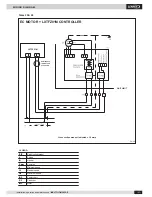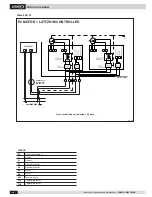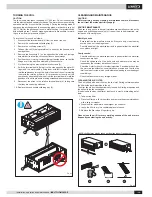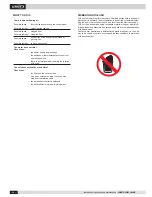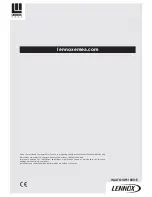
• 16 •
3 cm/m
+
+
+
+
+
ǻS
OU
T
OU
T
IN
IN
Installation, operation and maintenance /
INALTO-IOM-1809-E
ELECTRICAL CONNECTIONS
CONNECTIONS TO THE TERMINAL BOARD
RECOMMENDATIONS!
Before carrying out electrical connections, ensure that the electricity supply
to the supply line has been cut off, checking that the on-off switch is in the
OFF position.
- Only quali
fi
ed electricians should carry out the electrical connections.
- Check that the mains supply is single-phase 230 Vac/1/50 Hz (± 10%).
- Operating the unit with voltages outside the above limits could cause
malfunction and renders the warranty null and void.
- The power supply line should be
fi
tted with at least a switch isolator in
conformity with European standard EN60947-3.
- Make sure that the electrical system is suitable for providing not only the
working current required by the unit, but also the necessary current for
powering household and other electrical appliances already in use. Any
electrical and mechanical alterations or tampering render the warranty
null and void.
The cables should be suf
fi
ciently long so that they are not permanently taut
or create throttling or compression on metal parts.
The power cables should be suf
fi
ciently long so that in the event of acci-
dental tugging the active wires are subjected to stress before the earth wire.
Connect the earth wire to the relative terminal marked with the symbol .
Comply with the safety regulations in force in the country of installation.
The electrical connections should be made to the terminal boards on the
side of the appliance. Each terminal is identi
fi
ed by the label to be found on
the terminal boards.
CAUTION !
FAILURE TO COMPLY WITH THE INDICATED CONNECTIONS MAY
CAUSE MOTOR BURNOUT!
CONDENSATE WATER DRAINAGE
The condensate drain pipe should slope downwards by at least 3 cm/m
and should not have ascending or throttled sections in order to ensure a
regular
fl
ow of water. It is advisable for a trap to be
fi
tted. The condensate
drain pipe should be connected to a rainwater drainage system. Do not
use sewage systems to avoid possible rising of odours in the event of
evaporation of the water in the trap. Upon completion of work, check
that the condensate
fl
ows out properly by pouring water into the tray. The
condensate water drainage system should be fabricated in a workmanlike
manner and should be periodically checked.
The manufacturer cannot be held liable for any damage caused by drip-
ping in the absence of a valve or of periodic maintenance of the drainage
system.
Pic. 25
Pic. 26
TRAP (PLUMBING)
H1=
∆
p/10
H2=((
∆
p/10)/2 + 30
∆
p=
in Pa
H1; H2 = mm
Pic. 27
Pic. 28
HYDRAULIC CONNECTION
M6 vent
with hexagonal head pin
MAIN HYDRAULIC CONNECTION
CAUTION !
Always use a wrench and counter-wrench for connection of the coil
to the pipes (pic. 25). If the valve is installed, suitably insulate the
valve body with insulating material (pic. 26).
Connect the water inlet and outlet pipes, observing the indications given
on the side of the unit. Correctly insulate the water supply pipes to prevent
dripping during the cooling mode of operation. A shutoff valve should be
inserted on the water supply pipe and a balancing valve on the outlet pipe.
The valve body and balancing valve should also be properly insulated to
prevent dripping. It is the installer’s responsibility to insulate properly and
the manufacturer cannot be held liable for any insulation work.
NOTE: It is always advisable to install the valve. In the heating mode
of operation the valve reduces consumption because upon reaching
the set temperature the circulation of water is stopped to avoid wa-
sting energy (the fan coil would otherwise continue to heat like a
radiator, even with the motor at a standstill). In the cooling mode of
operation the valve stops the circulation of water when the set tem-
perature is reached, this stopping the internal exchanger from con-
tinuing to condense water with possible undesirable dripping onto
the fl oor. It also reduces chiller operation with consequent energy
saving.


